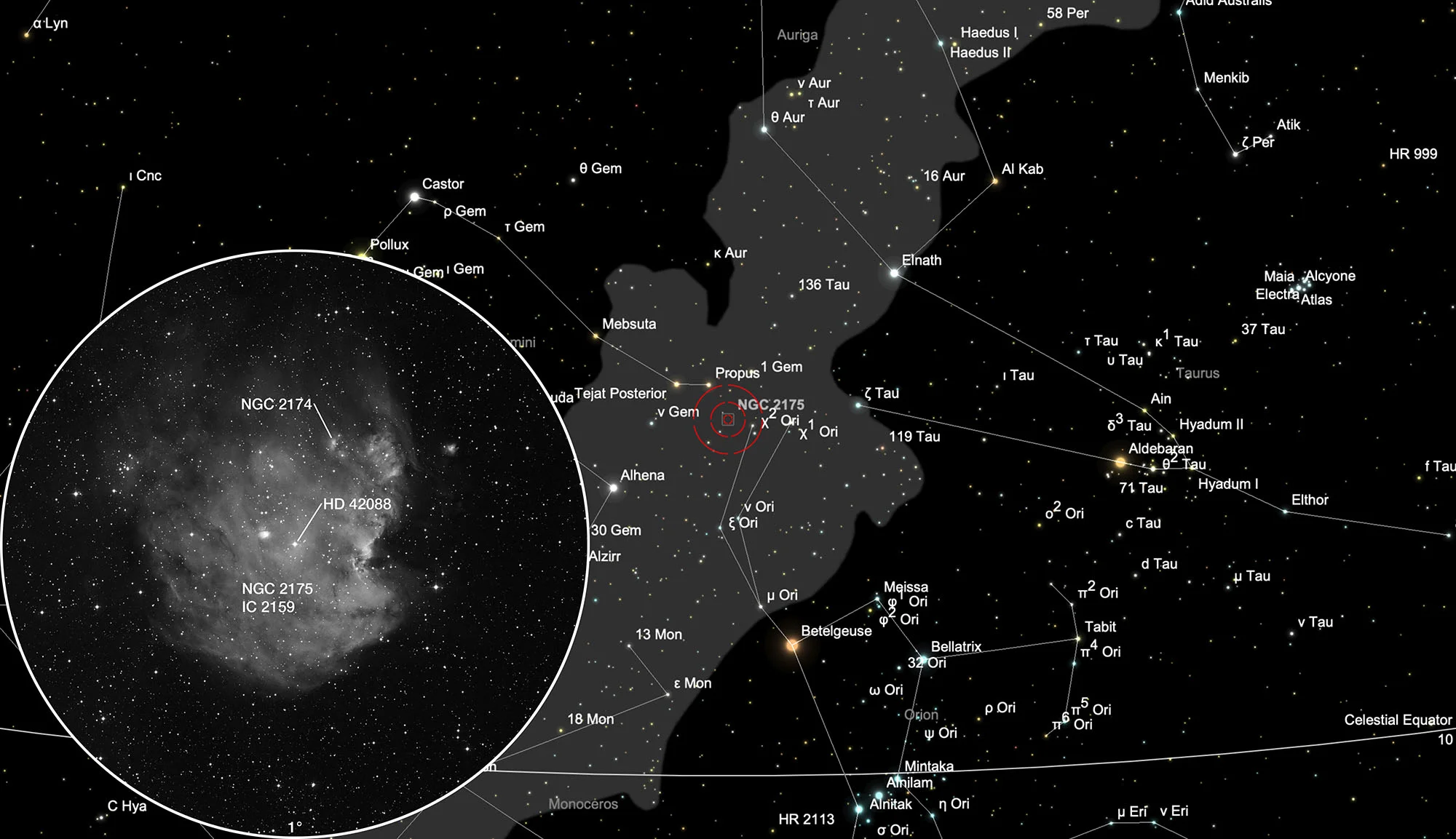Monkey Head Nebula (NGC 2175)



History
The open star cluster in NGC 2175 was probably sighted before 1654 by the Italian astronomer Giovanni Battista Hodierna. Hodierna discovered many of the nebulae known today, but his 1654 publication was little known outside of Sicily, so it was not known by Messier, the Herschels, and Dreyer. It was only rediscovered in 1980.
In 1857, the nebula-shrouded open star cluster was rediscovered by the German astronomer Christian Bruhns. According to John L. E. Dreyer he described it as an 8th magnitude star shrouded in a nebula. On 6 February 1877, French astronomer Édouard Stephan pointed his telescope at this point in the sky and discovered «a very faint nebula between three very faint stars», which later was recorded as NGC 2174. Its coordinates and description match a bright node in the northwestern part of the nebula. NGC 2174 is often mistakenly used for the entire nebula and NGC 2175 for the open star cluster. On 11 February 1890, the French astronomer Guillaume Bigourdan recorded a «very faint, very large, diffuse nebula» whose coordinates with IC 2159 point to a southern part of the whole nebula. He mistakenly believed that the nebula NGC 2175 listed in the New General Catalogue, published two years earlier, referred to the bright node east of the star HD 42088 and corrected its right ancension in the second Index Catalogue, published in 1910. [196, 313, 315]
Physical Properties
NGC 2175 is a young star cluster and active star-forming region enveloped in an H-II region. The radio source 3C 153.1 is also located here. The distance is about 1.6 to 2.2 kpc, about 5200 to 7100 light years. [146]
| Name | RA | Dec | Type | Dim | MD | Dreyer Description | Identification, Remarks |
|---|---|---|---|---|---|---|---|
| NGC 2174 | 06 09 00.3 | +20 38 26 | EN | 3.5 × 2 | 2.000 | eF, bet 3 vF st | CED 67A; knot in N 2175 |
| NGC 2175 | 06 09 38.6 | +20 29 18 | EN | 40 × 30 | 2.000 | * 8 m in neb (Auw No 21) | GC 1366; LBN 854; OCL 476 |
| NGC 2175 S | 06 10 54.0 | +20 36 36 | OCL | 5 | * 8 m in neb (Auw No 21) | GC 1366; Lund 1182; near N 2175 | |
| IC 2159 | 06 09 57.0 | +20 25 54 | EN | 2.000 | vF, vL, dif | CED 67B; in N 2175 |
Finder Chart
The galactic nebula NGC 2175 is located in the constellation of Orion, which is best visible from August to May. Turn the card upside down and you will see the monkey head in the DSS section.
Visual Observation
300 mm Aperture: In the 21 mm Ethos eyepiece the nebula is invisible without O-III filter. In the O-III filter it turns out to be a large, diffuse, structureless nebula around the bright star HD 42088. — 300 mm f/4 Popp Newton, Titlis 3020 m. a.s.l., SQM 21.20, 30 October 2022, 00:20, Bernd Nies
762 mm Aperture: The Monkey Head Nebula NGC 2175 can already be guessed without a filter, although it is clearly visible and very extended with an OIII filter. A dark spot is clearly visible somewhat off-centre. Around the brightest star, a somewhat brighter extended spot can be made out. — 30" SlipStream-Dobson f/3.3, Hasliberg, 28. 12. 2024, SQM-L 21.05, Elena + Eduard von Bergen
